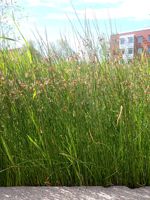Mon-Fri 9am - 5pm Mountain time
Baltic Rush vs Nodding Onion
Juncus balticus
Allium cernuum
CUSTOM GROW
NOT AVAILABLE THIS SEASON - MIGHT RETURN
Baltic Rush is a widespread native perennial rush that forms dense clumps of upright, cylindrical stems. Well adapted to saturated soils, it is common in wetlands, streambanks, and riparian zones, and is tolerant of both fresh and saline conditions. Hardy and low-maintenance, Baltic Rush contributes to soil stabilization and enhances wetland habitats.
It offers cover for small animals, nesting habitat for birds, and limited forage for livestock when young and tender. Its dense growth and rhizome networks add structural diversity that supports wetland ecosystems, making it well-suited for riparian planting, shoreline stabilization, wetland restoration, and reclamation projects.
Nodding Onion is a native perennial wildflower known for its nodding clusters of flowers that range in color from white to pink to purple. The lightly scented blooms provide pollen and nectar for pollinators, especially bees, which can collect while hanging upside down, a capability most other insects lack.
The narrow, grass-like leaves of the Nodding Onion can be used as a seasoning in cooked dishes, though bulbs and raw leaves should not be eaten in large quantities. All parts of the plant have an onion-like aroma when bruised, which helps deter deer and rabbits. They can self-seed readily, so removing spent blooms helps manage their spread. Tolerant of a range of soils, including alkaline, it is well-suited for a variety of plantings, including pollinator gardens and naturalization projects.
Baltic Rush Quick Facts
Nodding Onion Quick Facts
Toxicity: raw leaves and bulbs can be midly toxic

